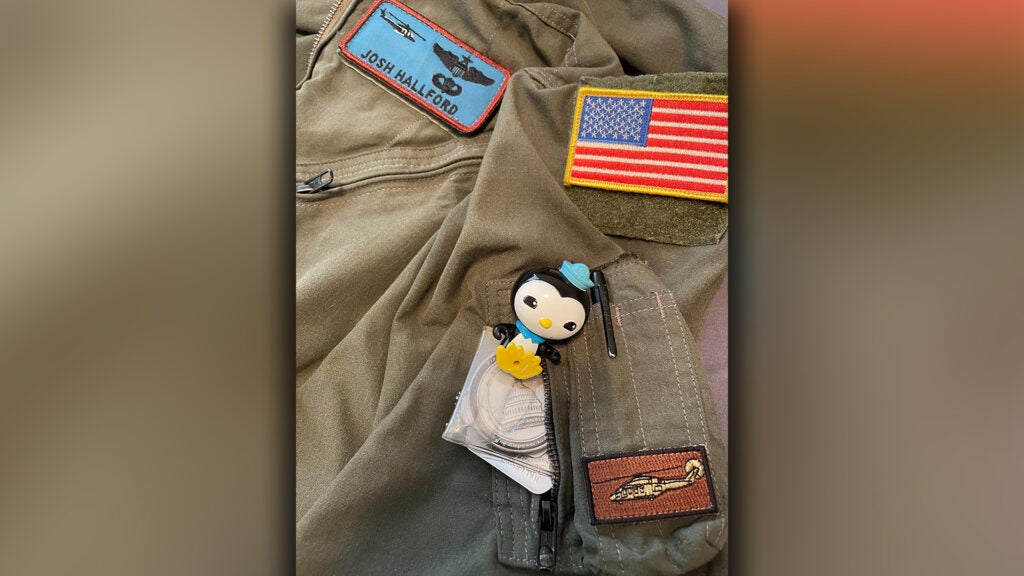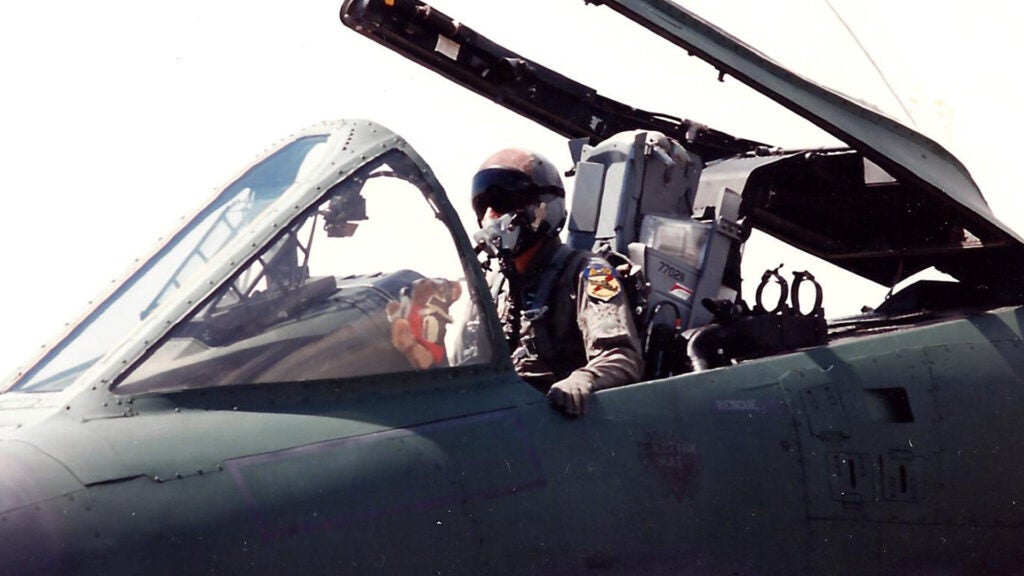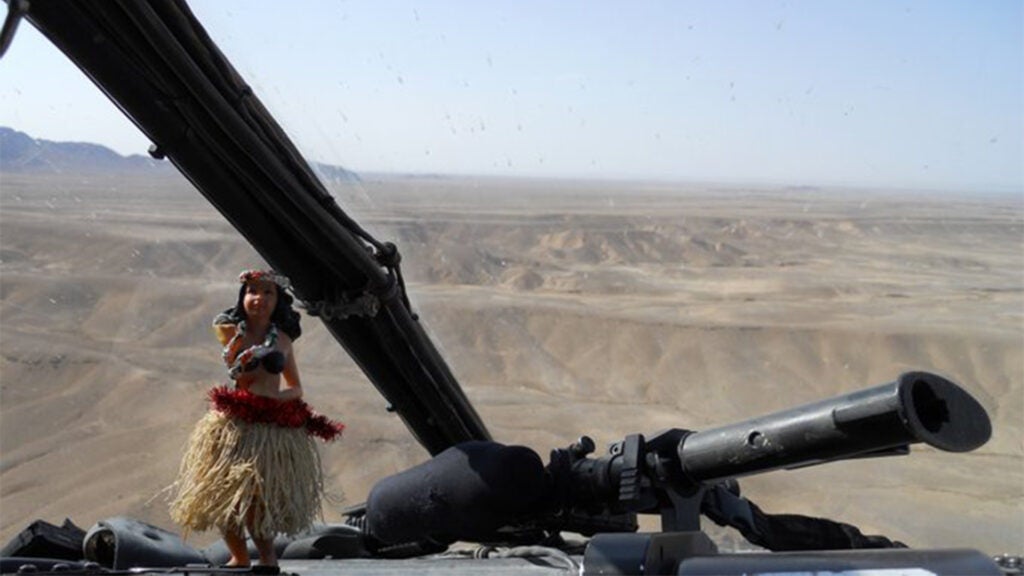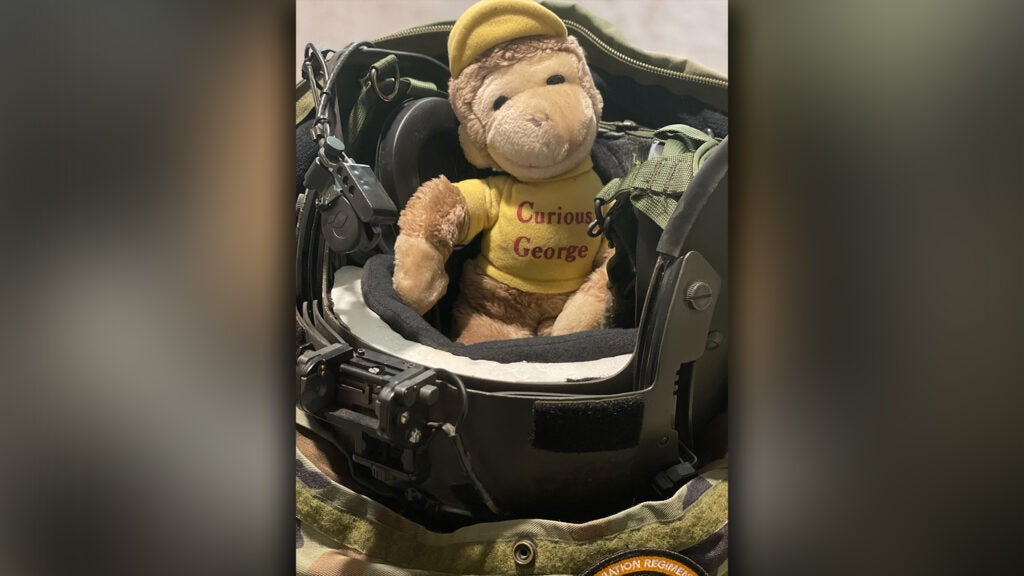Maj. Josh “Bowser” Hallford flies helicopters for the Air Force, but when he’s at home with his five-and-a-half year old son Logan, they watch a TV show called Octonauts together. The show is about a group of undersea explorers who go on adventures together, and one of Logan’s favorite characters is Peso, a penguin who serves as the team’s medic. It meant a lot, then, when Logan gave his dad a key-chain-sized Peso toy to take with him on the job.
“My son knows that Peso keeps Daddy safe while he’s flying,” Hallford told Task & Purpose. “He was four at the time and I was very touched by his generosity of giving away one of his favorite characters.”

A year-and-a-half later, Peso has about 200 flight hours in both the UH-1N Huey and the newer MH-139 Grey Wolf helicopters. But Peso is not the only toy or stuffed animal to get so much air time: Hallford was one of four pilots to share their stories of flying with cockpit buddies with Task & Purposes. These ‘cockpit buddies’ often start as tokens from loved ones, and then become an extra security blanket in the high-risk world of military aviation.
“Just about every squadron has at least one pilot or crew member that has some ‘routine’ involving something that has a personal connection, whether that’s a stuffed animal, flying with a flag that has some history, or some other memento,” said retired Lt. Col. Gregg Montijo, whose teddy bear the “Red Bear-on” gathered more than 1,000 flight hours — at least 300 of which at high-G — while Montijo was the West Coast A-10 Demonstration Team pilot.
Montijo was newly married in 1989 when he first joined the A-10 demo team. He constantly traveled for the job, so his wife bought him the bear to take a small slice of home with him.
“I spent an average of about 220 days a year gone to air shows and she wanted me to have a reminder,” Montijo said.

On every sortie, the pilot pushed the jet to its max performance, up to 7.2 Gs and 350-450 nautical miles per hour (403 to 518 miles per hour). He flew upside down and was authorized to go as low as 50 feet above the ground, though he rarely did that since people in the crowd could not see him that low, Montijo explained. The Red Bear-on hung tough through it all, just like his namesake, Manfred von Richthofen, the WWI flying ace known to history as the “Red Baron.”
“He had very high G-tolerance, never got tired, never passed out and was always ready for another sortie,” Montijo said about the bear.
The Red Bear-on retired in May 1992, when Montijo’s rotation with the A-10 demo team ended. But the pilot brought the bear back to the cockpit for his ‘fini-flight‘ when he retired from the Air Force in 2001. The bear still brings back fond memories.
“The demonstration pilot job was the best one I had in my 20-year career,” Montijo said. “He flew almost all the air shows with me, pulled many “G’s” over the years, was the team mascot and did a lot of other extra ‘off duty’ activities.”

The Red Bear-On is just one example of the attachments that pilots and their aircrew form with their miniature copilots. Another example is Shakira, the bobblehead hula dancer that Chief Warrant Officer Four Mark Leung met on an Air Force weather forecaster’s desk in Kandahar during his first trip to Afghanistan in January 2008.
“Right when I first got there, the weather forecaster in the outgoing unit had her on a speaker on his computer and I just made the comment of ‘oh man I love these Hula dolls. I always wanted to get one to fly with,’” recalled Leung, who was a chief warrant officer two at the time. “And he was like ‘hey if you want, you can have her, sir.’”
Leung said he had a vague recollection of a World War II movie where a pilot had a hula dancer set up on the control panel, so Shakira looked just right on the dashboard of his own OH-58D Kiowa helicopter. The name came from the actual musical artist Shakira, whose song Hips Don’t Lie became an international hit just two years earlier. The hula dancer definitely earned her namesake over the course of Leung’s tour.
“Whenever we opened up with the .50 cal, she’d start dancing around,” Leung recalled. “So the saying was ‘trust Shakira, her hips don’t lie, she’ll get you rounds on target.’”

Soon, her reputation spread across the unit, to the point where new pilots flying with Leung would bobble Shakira’s head and take a picture with her. Even the crew chiefs got in on it, gluing her back together or repairing her broken spring whenever she got hurt. A war zone can be a tough place for a five-inch plastic bobblehead.
“The crew chiefs would work fast to find a replacement part, put her back together, then put her on my desk for the next day’s flight,” Leung said. “It became part of the normalcy. They knew as soon as I got in the cockpit I’d clip her to the dash.”
But over the course of 1,000 combat hours during two tours of Afghanistan, Shakira became more than just a bauble on the dashboard. She became an essential part of the aircrew.
“I would not have flown in Afghanistan without her,” Leung said. “I mean I would have, but I would have been uncomfortable. She definitely became a lucky charm.”
Related: The adorable story of Scoff, the plushy ducky who flies in an F-15
There were a few hairy missions that ended with him and his co-pilot joking that Shakira had protected them, the aviator said, and they would “give her a little bobble” in thanks.
Unlike other flight buddies in this article, Shakira was solely a combat girl and not for peaceful stateside missions, Leung said. After all, even lucky charms have only so much mojo to go around. But while her flying days are over now, the hula dancer may have inspired others in Leung’s unit to bring similar totems in the cockpit with them.
“As she grew in popularity, a few other guys had some similar devices” like bobbleheads or stuffed animals or other funny little things, the pilot said. During an earlier tour in Iraq, Leung said a senior warrant officer had a purple stuffed gorilla which, unfortunately for the owner, was photographed by a visiting reporter and published back home.
“Our squadron commander was not too pleased with this huge photo of a purple stuffed gorilla prominently displayed in the aircraft, but that was the only time I heard anyone disapprove” of the flying buddies, Leung said.
The purple gorilla wasn’t the only stuffed monkey flying in a U.S. Army helicopter over Afghanistan. Col. Jason Davis (then a captain) saw the movie Curious George with his daughter right before he deployed. It was the first movie she ever saw in theaters, so it was curious indeed when Davis found a stuffed animal version of the monkey in a box left behind in his predecessor’s office when he took over in Bagram in 2006.

“I sent her a picture of him after she saw the movie and she said he could bring me good luck,” Davis said. And that was how Curious George became a combat pilot.
“Lots of us in the military are superstitious,” Davis explained. “George brings good luck!”
Over the course of two deployments to Afghanistan and missions around the world from Fort Polk to Belgium to Malaysia, George accumulated 800 combat hours “and maybe a thousand-yard stare,” Davis said. The monkey also had the honor of calling ‘cherry’ or ‘ice’ on combat missions. Cherry/ice is Army shorthand for declaring whether a landing zone is “ice,” meaning clear or cold and therefore safe to land in; or “cherry,” meaning contested or hot, and therefore much less safe to land in.
“I would typically say ‘George calls ice’” over a clear landing zone, Davis explained. “When there were actual hot LZs during MEDEVAC missions, I typically didn’t have time for playful banter, but one time I did say something like ‘George is going to be pissed if we get shot up on the ground here, please hurry up and get the patient.’”
George soon became a beloved part of the team, to the point where another aircrew kidnapped him.
“George was ‘beloved’ enough to survive one kidnapping when I left him in the aircraft,” Davis said. “The ‘proof of life’ picture was with some other stuffed animals who flew with certain people and he was returned quickly … unharmed. Not frozen in a block of ice.”

By this point, some keyboard warriors may be thinking: ‘Hey those flight buddies aren’t allowed in the cockpit! Do they know how much damage those things could do rattling around at high-Gs?’ To which the helicopter pilots might reply that their aircraft are not capable of going up to very high-Gs. Plus there was plenty of other gear to strap down, too.
“The Army requires equipment to be secured,” Davis said. “I always claimed [George] was secured up front and safer than our publications bag,” a hefty volume where all the flight charts, checklists and other paperwork are stored.
Likewise, Leung pointed out the mounted M4s, smoke grenades, magazines, snacks, Rip-Its, bandolier pouches, and other gear that also got clipped to the dash of the Kiowa. Meanwhile, in the A-10, the Red Bear-On seemed to do just fine flying at high Gs in Montijo’s aircraft.
“As for soft fluffy stuffed animals, I can’t remember anything that prohibited them,” said Montijo, though he admitted he was not up to date with current rules.
Finally, Peso the medically-trained penguin is small enough to fit in Capt. Hallford’s left shoulder pocket, “so he is never loose in the cockpit,” the pilot explained.
That’s fantastic, because Peso may still have a long flying career ahead of him.
“He’s logged test mission support and search and rescue support over the Gulf of Mexico; sling load, water bucket, paradrops with the 7th Special Forces Group, and night missions in his short career,” Hallford said. “And he should be adding flight test soon.”
In a way, Peso is steeped in a family legacy of miniature sky warriors.
“It reminded me of my dad having a “jump buddy” when he was a paratrooper at the 82nd [Airborne Division] when I was about the age of my son,” Hallford said. “His was a pound puppy.”
All of which goes to show that when it comes to military life, all the little things matter. Especially the little buddies.
Related: An F-35 pilot reveals why good fighter pilots never skip leg day
The post These stuffed animals have way more flight-hours than you appeared first on Task & Purpose.
